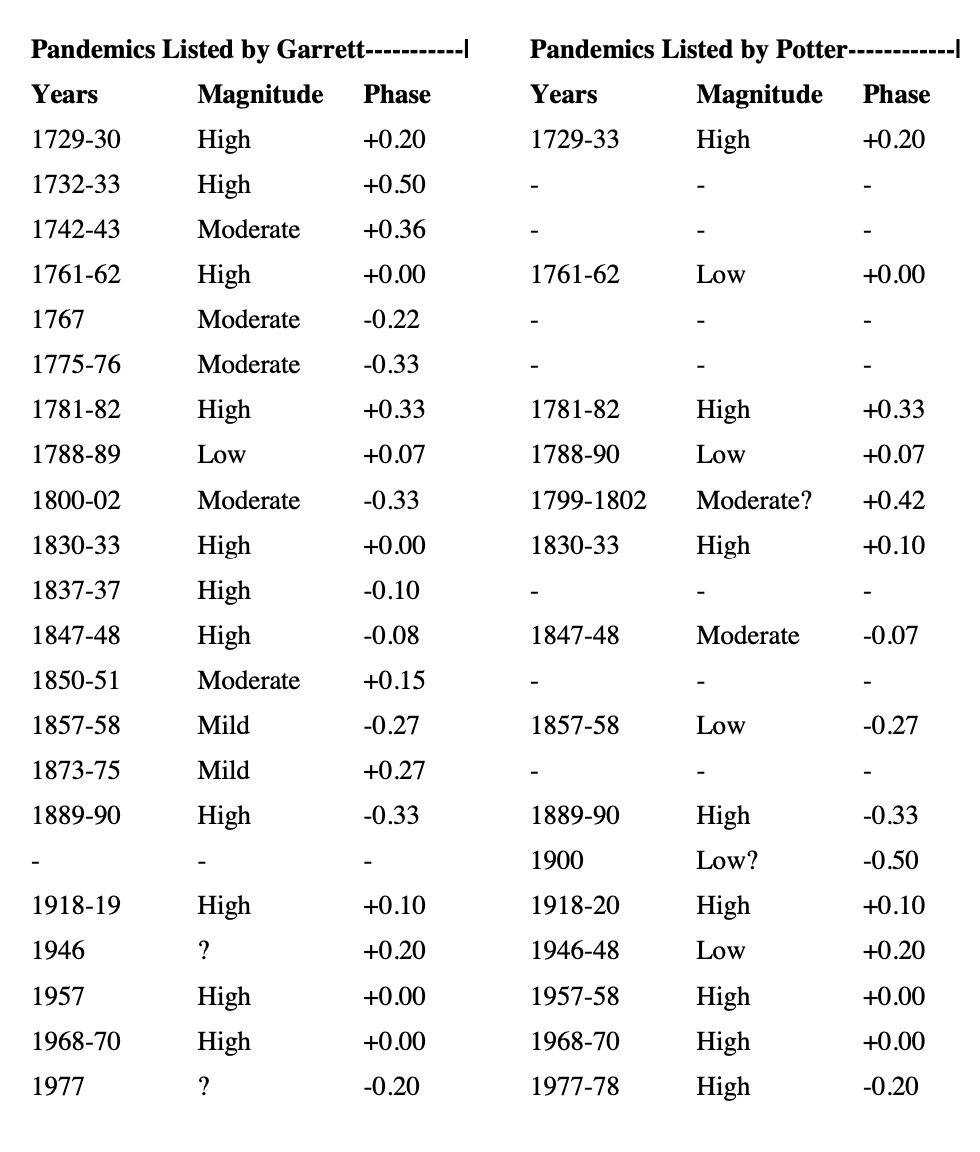Influenza pandemics and solar activity
123 K.F.Tapping,R.G.Mathias ,D.L.Surkan

January 2021
Dominion Radio Astrophysical Observatory, National Research Council, P.O. Box 248, Penticton, BC, V2A 6K3, Canada
Department of Health Care and Epidemiology, University of British Columbia, 5804 Fairview Avenue, Vancouver, BC, V6T 1Z3, Canada
Paper accepted for publication in the Canadian Journal of Infectious diseases.
Kilbourne (1), suggested a quasi-decadal recurrence pattern to influenza pandemics. One natural rhythm with such a time-scale, which is widely evident in many aspects of the terrestrial environment, is the 11-year cycle of solar magnetic activity. The impact of the solar magnetic activity cycle upon our environment are extensive and well documented (e.g. 2, 3).
We have made a search for any correlation in the occurrence of influenza pandemics with the solar magnetic activity cycle. We used two pandemics lists (Garrett, 4 and Potter, 5).

Good-quality observations of solar magnetic activity (numbers of sunspots) are available back to at least 1700, which was therefore chosen as the starting point for the study.
The duration of the "11-year" solar activity cycle actually ranges from 10 to 13 years. To compare the data we normalized the duration of each activity cycle to unity, and the sunspot number to 100. This provided an average activity cycle for comparison purposes. We then expressed the position of each pandemic in its (normalized) solar activity cycle in terms of a "phase offset", given by (Year of Pandemic - Year of Maximum)/(Year of Cycle End - Year of Cycle Start).
An event at the solar maximum would have an offset of zero, and one at solar minimum would be at an offset of plus or minus 0.5. The pandemics in the two lists and the associated phase offsets are given in Table 1.
The phase offset values were divided into bins (-0.5 to -0.3, -0.3 to -0.1, -0.1 to +0.1, +0.1 to +0.3, +0.3 to +0.5) and the pandemics binned according to their phase offsets. The two distributions were scaled to have a mode of 100, and plotted with the average activity cycle in Figure 1. There is a definite apparent tendency for pandemics to be more likely around solar activity maxima.
Table 1: Pandemics Since 1700 as Listed by Garrett (1994) and Potter (1998)

To estimate the probability that the association could simply be a random event, a simulation run of one million trials was carried out. In each trial a number of events equal to the number in the list in question (21 and 15 respectively for Garrett and Potter), were assigned random phase offsets in the range -0.5 to +0.5 and then binned in five bins.
If bins 3 (phase offset in range -0.1 to 0.1) and bin 4 (phase offset from 0.1 to 0.3) together contained at least 12 observations (Garrett) out of 21 or 9 observations out of 15 (Potter), with no other bin containing more than 3 (Garrett) or 2 (Potter), then the trial was deemed a success.
Otherwise the trial was designated a failure.
Table 2

Figure Caption: The two distributions of pandemic count versus phase offset scaled to a peak value of 100. Pandemics listed by Garrett and Potter are shown respectively in solid black and white. The circles connected by solid lines show an average solar activity cycle, also scaled to have a peak value of 100.
From this simulation, we estimate that the probability of obtaining a result leading to the reported conclusion on a random basis is less than 2%. We conclude therefore that there is a significant probability that influenza pandemics are more likely during solar magnetic activity maxima.
The solar-environmental connection is well-established, but the factor modulated by the Sun that affects the development of influenza pandemics is not known.
References
Kilbourne ED. An Explanation of the Interpandemic Antigenic Mutability of the Influenza Virus. Journal of Infections Diseases 1978;128:668-670.
Withbroe GL, Kalkofen W. Solar Variability and its Terrestrial Effects. In: Pap JM, Frölich C, Hudson HS, Solanki SK, editors. The Sun as a Variable Star. Proceedings of International Astronomical Union Colloquium No. 143, 1993 Jun 20-25; Boulder, Colorado, USA. Cambridge University Press; 1994. p. 11-19.
Lang KR. The Sun, Earth and Sky. Springer Verlag; 1995.
Garrett L. The Coming Plague. Penguin Books; 1994. p. 633-637.
Potter CW. Chronicle of Influenza Pandemics. In: Hay AJ, Nicholson K, Webster RG, editors. Textbook of Influenza. Blackwell Science, Oxford; 1998. p. 3-18.
































2 Comments